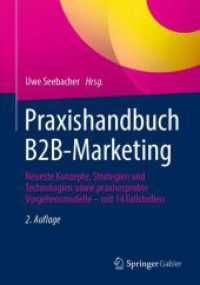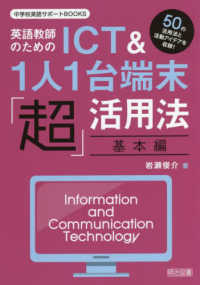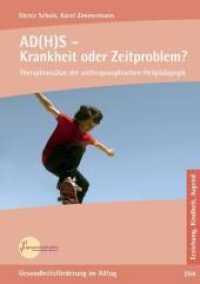- ホーム
- > 洋書
- > 英文書
- > History / World
Full Description
The present volume is the fifth publication of a Frontinus-conference
edited by Gilbert Wiplinger as a BABESCH supplement volume on historical
water science. At the place of activity of Sextus Iulius Frontinus as
curator aquarum and the capital of the Roman Empire it was
probably one of the most important and challenging events of this
congress series.
For the first time a new path was taken, as the organizer and publisher
wanted to approach the topic water from the artistic side. This was
realized in the opening lecture with the presentation of a novel in
which Frontinus plays the main character and a photo exhibition at the
Austrian Historical Institute about the integration of the Aqua Claudia
and the Aqua Anio Novus in the new building of the waterworks of Limburg
(Holland).
In eight sections 33 contributions are published in this volume. The
first section deals with the different approaches to the topic of water.
The second section is dedicated to the award of the Frontinus Medal to
Hubertus Manderscheid, who was honoured during the conference for his
fundamental research on the history of ancient water supply over many
decades.
The third section is dedicated to the aqueducts of Rome. After a general
introduction, Colle Papese in Tivoli, the Aqua Alsietina and the
distribution of the Aqua Claudia and Anio Novus within the city were
discussed. The next section was devoted to aqueducts and water supply
outside of Rome, presenting Pompeii, Tauromenion (Italy), Spalato
(Croatia), Parion, the Şirince Aqueduct of Ephesus, Syedra (Turkey),
Gerasa (Jordan), Sepphoris (Israel) and the pre-desert areas along the
African Limes.
The topic of the fifth section are toilets and baths: the toilets of
Rome, the latrines of the baths of Caracalla, public baths in Late
Antique Rome and the Roman baths of Parion (Turkey). Fountains was the
topic of the sixth section with supply devices and water effects in
Roman Imperial nymphaea, a fountain of a triclinium near
the Temple Mount in Jerusalem, fountains in the Terrace Houses of
Ephesus and the multi-sensory effects of water in Roman and Late Antique
elite houses.
The seventh section deals with hydraulic engineering: Frontinus'
quinaria, the Nîmes aqueduct and castellum and planning
and building an aqueduct without the use of surveying instruments. In
the last section various topics were summarized with the feeling of
water in Trajanian times, downdrains in Ostia and water machines in
Medieval Arabic texts.
The conference programme was impressively complemented by several
full-day and half-day excursions. It offered the opportunity to visit
monuments that are otherwise not accessible to the public. Once again it
became clear that neither a lecture, nor a publication or pictures can
replace the encounter with real archaeological findings. The
presentation of new research results on ancient hydraulic engineering
and the enhancement of knowledge by visiting comparative examples on
site is the declared aim of this conference series.







